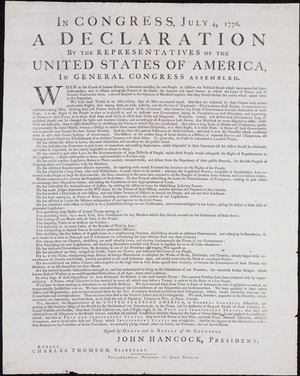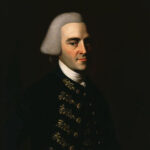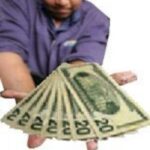Of course everyone has seen the beautifully hand-written version of the Declaration of Independence on display in the National Archives. However, did you know that there are four other versions of the Declaration out there, all with the same history-making text but printed in different ways and with different signatures? Read on for a brief and fascinating history of America’s most famous document and how it could affect you today.
The Dunlap Broadside and the ‘Fair Copy’
According to the National Archives, on Ju;y 4, 1776, the Second Continental Congress, led by John Hancock, approved the final text of the Declaration, written by a committee of five delegates headed by Thomas Jefferson. The next duty of the Congress was to publish the document for their fellow countrymen, and their former rulers, to read. The Declaration was printed by John Dunlap and delivered to the Congress on July 5. One copy was placed in the official minutes of the Congress and another was sent to Gen. Washington to be read to the troops. We don’t know how many other copies were printed of what is now called the Dunlap broadside but 26 are known to still exist. The original document that Dunlap used to set his type, now known as the ‘fair copy,’ has been lost.
The Engrossed Copy: The version at the National Archives
The Dunlap broadside was signed only by John Hancock as president of the Congress and by Charles Thomson as secretary of the Congress. On July 19, the Congress ordered that an engrossed (meaning carefully handwritten) copy be written on parchment for signature by the delegates. The engrossed copy was finished on August 2 and the attending delegates, perhaps 36 out of the eventual 56, signed on that day. John Hancock, as president of the Congress, signed first in a large, bold script which some later joked was to make his signature large enough for King George III to read without his spectacles. Over the next couple of months the remaining delegates signed the document so that it appeared as it does today. This document was kept secret to protect the signers from reprisals by the British.
The Goddard Broadside: The second printing of the Declaration
In January 1777, the Congress ordered a printing based on the engrossed copy with the delegates’ names included, with one copy for each of the states to place in their official archives. This is known as the Goddard broadside after its printer, Mary Katherine Goddard. Like the Dunlap broadside, this document is set in type, not a reproduction. Only 9 copies are known to exist.
The 1823 Stone Engraving: The official reproduction of the Declaration
This was the last ‘official’ reproduction of the Declaration until 1820, when then-Secretary of State John Quincy Adams, ordered a reproduction of the document to be completed by William J. Stone. It took Stone three years to produce the required engraving plate from which Adams had 200 copies printed on parchment. Stone made other ‘unofficial’ printings which are identified by his name only without reference to Adams or the Department of State. Of the original 200 copies, 33 are known to exist. Other facsimiles of the Declaration made during this period were produced by Benjamin Owen Tyler and John Binns. These reproductions are from hand-engraved plates using the engrossed original as a model but with sometimes extravagant embellishments.
Where Are All of the Other Copies?
Depending on your point of view, the real Declaration of Independence is the engrossed version in the Rotunda for the Charters of Freedom in the National Archives. Or it could be the lost ‘fair copy’ used to make the Dunlap broadside. But what about all of the other ‘original’ copies?
Strange as it may seem, lost copies of the Declaration of Independence are found every few years. As recently as 2007, proof copies of the Declaration by William Stone have been offered for sale at auction. In 2009, the British National Archives in Kew, England revealed that a researcher had found an original copy of the Dunlap broadside while searching through some documents from the 1700s.
Most amazing was the recent find by a man in Nashville, TN who unwittingly bought a copy of the 1823 Declaration by Stone for $2.48 in a thrift store. According to MSNBC and the Associated Press, it later sold for almost a half million dollars.
Who knows? Maybe you’ll be the one to find the real Declaration of Independence.
Sources:
MSNBC/AP, “Declaration of Independence copy sold.” March 23, 2007.
http://en.wikipedia.org/wiki/United_States_Declaration_of_Independence
www.archives.gov/exhibits/charters/declaration_history.html National Archives
http://www.loc.gov/exhibits/declara/declara4.html Library of Congress
www.nps.gov/inde/ Independence National Historical Park
www.ushistory.org/declaration/
Related article about the Declaration of Independence:
20 Fun Facts About the Declaration of Independence





